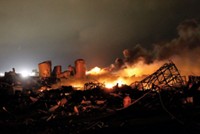Advertisement
Grab your lab coat. Let's get started
Welcome!
Welcome!
Create an account below to get 6 C&EN articles per month, receive newsletters and more - all free.
It seems this is your first time logging in online. Please enter the following information to continue.
As an ACS member you automatically get access to this site. All we need is few more details to create your reading experience.
Not you? Sign in with a different account.
Not you? Sign in with a different account.
ERROR 1
ERROR 1
ERROR 2
ERROR 2
ERROR 2
ERROR 2
ERROR 2
Password and Confirm password must match.
If you have an ACS member number, please enter it here so we can link this account to your membership. (optional)
ERROR 2
ACS values your privacy. By submitting your information, you are gaining access to C&EN and subscribing to our weekly newsletter. We use the information you provide to make your reading experience better, and we will never sell your data to third party members.
Policy
Safer technology
September 18, 2006
| A version of this story appeared in
Volume 84, Issue 38
It's hard to see why anyone would be against inherently safer technology in chemical manufacturing plants, as would be required by legislation introduced by Sens. Frank Lautenberg (D-N.J.) and Barack Obama (D-Ill.) (C&EN, May 15, page 11). Yet the American Chemistry Council and its president, Jack N. Gerard, are adamantly opposed to the bill.
Gerard said, "We've proven we are safe"; however, his organization's statistics indicate about 2,000 accidents per year for 1990-2003 with no decline (C&EN, April 19, 2004, page 29). The Chemical Safety & Hazard Investigation Board is still very busy investigating accidents.
He also said, "Why allow government to come in and set standards? The industry knows better." Indeed, some of the strongest supporters of inherently safer chemistry have had extensive experience in industry, including, for example, Trevor Kletz (ICI), Dennis Hendershot (Rohm and Haas), and me (Hercules).
Assistance from outside a company can be helpful. An evaluation of processes at Dow Chemical's Midland, Mich., plant that was done with the help of the Natural Resources Defense Council resulted in changes that saved the company $5 million a year. A Massachusetts law requires companies to reevaluate their processes with respect to pollution prevention and safer chemistry but does not require them to adopt the new processes. Many of them have, however, with savings of over $77 million.
Some companies have adopted safer processes on their own without prodding. GE eliminated phosgene and methylene chloride by changing to diphenyl carbonate for the synthesis of polycarbonate. Some Japanese companies have eliminated the use of hydrogen cyanide in the preparation of methyl methacrylate by starting with the air oxidation of isobutylene to produce methacrolein. After Sept. 11, 2001, the Washington, D.C., water treatment plant switched from chlorine to sodium hypochlorite for disinfection, and the change took only a few weeks.
Change can be hard. Some oil refineries objected to legislation designed to remove lead from gasoline. The auto industry objected to requirements for seat belts and air bags in cars; it also objects to improved fuel efficiency standards.
Gerard probably objects to inherently safer chemical technology because his member companies are afraid the change would make them spend money. There will be a capital expense. One needs to balance the costs against those of accidents, more fences, more guards, surveillance systems, and the possibility that a terrorist would put holes in their tanks with a high-powered rifle. The Alaska pipeline was punctured in this way.
If a biocatalytic process is substituted for the chemical one, the terrorist would be shooting at the equivalent of a brewery. Why would he want to do this? As pointed out above, the new process may be cheaper. The payback period may not be long. Many companies give lip service to innovation. Inherently safer technology is a good place to apply it.
Albert S. Matlack
Hockessin, Del.




Join the conversation
Contact the reporter
Submit a Letter to the Editor for publication
Engage with us on Twitter